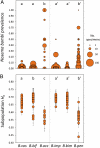Patterns of widespread decline in North American bumble bees
- PMID: 21199943
- PMCID: PMC3021065
- DOI: 10.1073/pnas.1014743108
Patterns of widespread decline in North American bumble bees
Abstract
Bumble bees (Bombus) are vitally important pollinators of wild plants and agricultural crops worldwide. Fragmentary observations, however, have suggested population declines in several North American species. Despite rising concern over these observations in the United States, highlighted in a recent National Academy of Sciences report, a national assessment of the geographic scope and possible causal factors of bumble bee decline is lacking. Here, we report results of a 3-y interdisciplinary study of changing distributions, population genetic structure, and levels of pathogen infection in bumble bee populations across the United States. We compare current and historical distributions of eight species, compiling a database of >73,000 museum records for comparison with data from intensive nationwide surveys of >16,000 specimens. We show that the relative abundances of four species have declined by up to 96% and that their surveyed geographic ranges have contracted by 23-87%, some within the last 20 y. We also show that declining populations have significantly higher infection levels of the microsporidian pathogen Nosema bombi and lower genetic diversity compared with co-occurring populations of the stable (nondeclining) species. Higher pathogen prevalence and reduced genetic diversity are, thus, realistic predictors of these alarming patterns of decline in North America, although cause and effect remain uncertain.
Conflict of interest statement
The authors declare no conflict of interest.
Figures



References
-
- Hegland SJ, Totland O. Is the magnitude of pollen limitation in a plant community affected by pollinator visitation and plant species specialization levels? Oikos. 2008;117:883–891.
-
- Corbet SA, Williams IH, Osborne JL. Bees and the pollination of crops and flowers in the European Community. Bee World. 1991;72:47–59.
Publication types
MeSH terms
Associated data
- Actions
- Actions
- Actions
- Actions
- Actions
- Actions
- Actions
- Actions
- Actions
- Actions
- Actions
- Actions
- Actions
- Actions
LinkOut - more resources
Full Text Sources
Molecular Biology Databases

